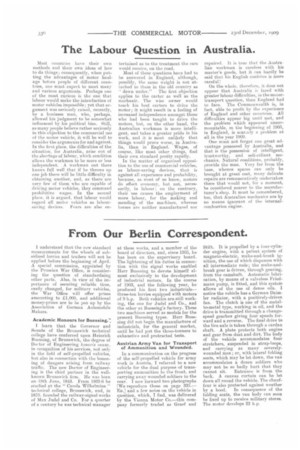From Our Berlin Correspondent.
Page 4

If you've noticed an error in this article please click here to report it so we can fix it.
1 understand that the new standard measurements for the wheels of subsidised lorries and trailers will not be applied before the beginning of April. A special commission, appointed by the Prussian War Office, is considering the question of standardising other parts. Also, in view of the importance of securing reliable tires, easily changed, for military vehicles, the War Office will offer prizes amounting to £1,000, a-nd additional money-prizes are to be put up by the Association of German Automobile M a kers.
Academic Honours for Suessing.7
I learn that the Governor and Senate of the Brunswick technical college have conferred upon Heinrich Buessing, of Brunswick, the degree of Doctor of Engineering honoris causer., in recognition of his services, not only in the field of self-propelled vehicles, Limit also in connection with the lessening of dangers arising from railway traffic. The new Doctor of Engineering is the chief partner in the wellknown Brunswick firm. He was born on -I9th June, 1843. From 1862-6 he studied at the " Carole Wilhelmina " technical college, Brunswick, and, in 1870, founded the railway-signal works of Max Jude] and Co. For a quarter of a century he was technical manager
at these works, and a member of the board of directors, and, since 1905, he has been on the supervisory board. The lightening of his duties in connection with the signal works enabled Herr Bue.ssing to devote himself almost exclusively to the development of industrial motors. In the course of 1903, and the following year, he produced his first two industrialsthree-ton lorries equipped with motors of 9 h.p. Both vehicles are still working, the one for Judd l and Co., and the other at Buessing's factory. These two machines served as models for the present Biteasing types. Herr Bliessing did not begin the manufacture of industrials, for the general market, until he had put the three-tonners to exhaustive and protracted tests.
Austrian Army Van for Transport of Ammunition and Wounded.
In a communication on the progress of the self-propelled vehicle for army work in Austria, I referred to a new vehicle for the dual purpose of transporting ammunition to the front, and carrying away wounded soldiers to the rear. I now forward two photographs l-We reproduce these on page 335.— ED.] and a few ntee on the vehicle in question, which, I find, was delivered by the Vienna Motor Co.—this oompany formerly traded as Grasf and Stift. It is propelled by a four-cylinder engine, with a patent system of magneto-electric, make-and-break ignition, the use of which dispenses with all intermediate rods ; the make-andbreak gear is driven, through gearing, from the camshaft. Automatic lubrication, by means of a valveless Friedmann pump, is fitted, and this system allows of the use of dense oils. I notice the vehicle has a German Daimler radiator, with a positively-driven fan. The clutch is one of the metalto-metal type, working in oil, and the drive is transmitted through a changespeed gearbox giving four speeds forward and a reverse. The final drive to the live axle is taken through a cardan shaft. A plate protects both engine and gear from dust and dirt. The body of the vehicle accommodates four stretchers, suspended in strap-loops, and carrying as many severelywounded men ; or, with lateral folding seats, which may be let down, the van accommodates a dozen soldiers who may not be so badly hurt that they
cannot sit. Entrance is from the hack. A canvas curtain can be let down all round the vehicle. The chauffeur is also protected against weather by a hood, In consequence of the folding seats, the van body can soon be fixed up to receive military stores. The motor develops 22 11.p.




















